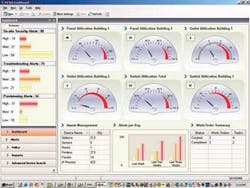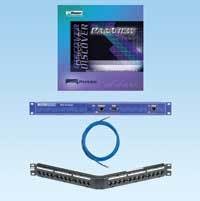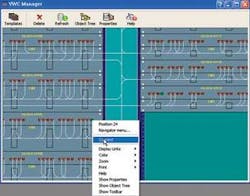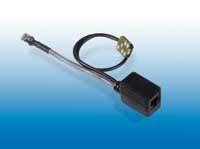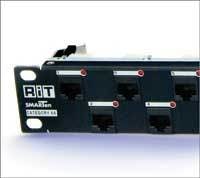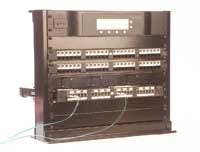While today’s intelligent infrastructure systems offer benefits for end users, system providers continue to face U.S. adoption challenges.
Intelligent patching systems, which have been around for almost 10 years, are now referred to as intelligent physical-layer management (IPLM), intelligent infrastructure management (IIM), or real-time infrastructure management. These systems provide such benefits as cutting management cost, improving physical network security, and tracking assets.
The PV360 Dashboard, a customizable part of RiT's IPLM, gathers information from the system's database, analyzes it, and graphically presents it.
With awareness of intelligent systems finally taking off in the U.S., many vendors are jumping on board, and the original providers have built in several enhanced features. Because the value proposition of these systems is geared mainly toward IT managers and administrators, vendors face the challenge of reaching out to these end users while increasing knowledge and endorsement among their installer base.
Technology players
RiT Technologies’ (www.rittech.com) PatchView solution is a combination of scanners, expanders, and masters deployed in a hierarchical configuration. Each scanner supports to up to 24 intelligent patch panels to monitor and report connectivity information. Expanders allow a virtually unlimited number of scanners to be controlled by the system, while the master views the entire system and reports to the PatchView for the Enterprise (PV4E) software that resides on a server.
The Panduit PanView system includes intelligent fiber patch panels, which are ideal for data center applications.
In certain countries, RiT offers its own end-to-end system with SMART fiber and copper patch panels, other connectivity hardware, and cable. But the company also partners with cabling system providers; vendors like ADC, Belden, Panduit, and U.K.-based Brand-Rex integrate RiT technology with their own products to offer a full IPLM system. For example, the Panduit PanView system is a combination of RiT scanners, expanders, masters, and software, plus Panduit intelligent fiber and copper patch panels and patch cords.
“The PanView System is differentiated by our software integration expertise and our enhanced line of intelligent patch panels, in addition to the capabilities provided by our technology partner, RiT,” says Michael Pula, product line manager for Panduit (www.panduit.com). “These intelligent patch panels accept Panduit modular Mini-Com jacks to enable customization of the panels.”
Pula adds, “The panels feature an LED indicator on each port as well as a ninth wire connection that mates with the ninth wire of the PanView patch cord. The ninth wire communicates port connectivity information from patch panel to patch panel. In addition, Panduit integrates PanView software with trouble-ticketing and asset management tools used by our customers to manage their IT infrastructure.”
iTRACS Virtual Wiring Center lets you view and manage a data center and wiring room in a two-dimensional view.
iTRACS Corp. (www.itracs.com) offers two IIM software solutions. Infrastructure Manager software is sold by participating OEM manufacturers while Physical Layer Manager is customizable software sold directly by iTRACS. Tyco Electronics, Siemon, Ortronics, Molex, and Nexans offer the iTRACS Infrastructure Manager software in conjunction with their intelligent patch panels, patch cords and analyzer hardware. Customers can upgrade software by purchasing Physical Layer Manager from iTRACS.
Like RiT, iTRACS communicates port information via a ninth wire in special patch cords. Instead of the hierarchical hardware components, the iTRACS solution works with an analyzer that monitors sensor pads on panel and switch ports, and then reports information directly to the software. “The combination of the analyzer and software is the only option for showing connectivity to the switch and the patch panel,” says Joel deNeuf, system engineer for iTRACS.
Systimax’s (www.systimax.com) iPatch Real Time Infrastructure Management system, which the company released in April 2001, is a combination of hardware and software developed solely by Systimax for use with their cabling system. “By developing our own system from the hardware to the software, we have more control over technology development,” says Michael German, global technology director for Systimax.
iPatch consists of fiber and copper intelligent patch panels, Rack Manager Plus to gather and communicate connectivity data, and iPatch software to manage, monitor, and control the system. “iPatch patch panels sense the physical presence of the plug in the port, so as soon as something is introduced or removed, the event is communicated,” explains German. “Our system uses standard patch cords, which we feel gives more flexibility to the end user. When you introduce a standard patch cord into a system that requires special patch cords, the system loses its ability to detect information, which could create network security problems.”
A newcomer on the “intelligent” scene, Hubbell Premise Wiring (www.hubbell-premise.com) introduced the PowerTrac patch panel in late 2005. PowerTrac also uses standard patch cords and supports 20-watt per port PoE and asset management. PowerTrac patch panels work in conjunction with a command module that can support up to 15 patch panels.
“The command module provides advanced provisioning and monitoring functions for PoE applications, and communicates information to software for asset management,” says John Smith, product manager for Hubbell. “PowerTrac detects connections at both the switch and the end device. It can detect the end device whether it’s powered on or off.”
Hubbell's PowerTrac system features asset tags that permanently attach to and track any network or non-network device.
Each port on the PowerTrac patch panel has two indicator LEDs, with the left LED signifying connection to the switch and the right LED signifying connection at the work area. Explains Smith, “When the right LED is off, there is nothing attached at the workstation. When it’s green, the device is connected but not drawing any PoE power. When it’s orange, the device is drawing compliant power, and when blinking there is a problem. While the system is designed primarily for PoE and asset management, it shows which ports are being used and which are connected to the switch.”
Value proposition
Intelligent infrastructure management features include the ability to track and document any changes to the patch field and store those changes in a database. Through software, these systems also offer work order processes that let you input scheduled connectivity changes and guide technicians through the steps. For example, with the Panduit PanView system, a blinking LED indicates that the patch cord must be removed. Once removed, a lighted LED indicates where the patch cord needs to be inserted. Each event is automatically recorded in the software.
“For larger installations with several racks, we take this one step further by implementing lamps on the top of each rack,” explains Pula. “It’s not only about accuracy and traceability, but also about speed of implementation. The LEDs and lamps give immediate attention to the location where the change is to occur. This allows systems to be configured and back up-and-running very quickly.”
Another key benefit of intelligent systems is improved security of the physical layer. When changes occur in the connections, the systems can send alerts via various communication methods, including e-mail, cell phones, and pagers. iTRACS, RiT, and iPatch all have the ability to disable LAN access in the event of an unauthorized connection.
One example of security is the iLogin feature available with iTRACS Physical Layer Management software. “iLogin polls the Windows domain login information to show us exactly who’s logged in where,” explains James Sherrin, system engineer for iTRACS. “We can even integrate the system with a building’s access control. For example if someone has not badged into the building but then logs into the network, we know that person either didn’t badge in or someone is using their network username and password. That’s a security concern.”
Most intelligent systems can also be integrated with CAD floor or building diagrams to graphically view, update, and physically locate every network connection. Systimax’s iPatch database maintains connectivity maps overlaid on CAD diagrams that are automatically updated when a change occurs. One-button tracing on the iPatch intelligent patch panel also lets technicians trace both ends of a connection.
SMARTen is RiT Technologies' 10-GbE-capable copper-based IPLM system.
“The user can press the trace button for a specific port, and the LED will light up at the corresponding end in a cross-connect scenario,” explains German. “In an interconnect, pressing the trace button displays the switch coordinates on the LCD display of the Rack Manager Plus.”
Tracking and analyzing
Asset management-the ability to track and analyze information about specific network devices-is another key benefit. iTRACS Physical Layer Manager software is available with an iDiscover feature that provides asset information for all devices connected to the network by obtaining data via SNMP from switches and other devices. “Through iDiscover, the iTRACS software can query information like location, disk capacity, operating system, and it can track the devices as they move around the network,” explains iTRACS’ deNeuf.
Hubbell’s PowerTrac management capabilities are aimed at asset management, not just ports or cables, which the company says is based on today’s need to track such devices as clocks, WAPs, and cameras that are in public areas and not assigned to any one person. The system features asset tags that permanently attach to any network or non-network device. For example, an asset tag can be affixed to a painting or statue and connected to the LAN. In addition to monitoring the port status at the workstation, the system detects and documents when the asset tag is removed or unplugged.
“Asset tags are ideal for VoiP applications where one of the key issues has been determining the physical location where an E911 call is made. With the asset tag, we know exactly where the phone is connected,” explains Smith.
The latest technologies found in intelligent infrastructure systems include support for 10-Gigabit Ethernet (10-GbE) over copper and fiber, and several new software features for specific applications. RiT was the first vendor to offer an IPLM system for 10-Gigabit networks, with partners Panduit and ADC following shortly thereafter. In March, Systimax announced iPatch for 10-Gigabit-over-copper and pre-terminated plug-and-play fiber shelves with MPO cable connector interface, designed for quick deployment in data centers. Hubbell also offers its system for use with 10-GbE fiber and copper applications.
RiT’s recent software features include an Automated Provisioning Tool and PV360 Dashboard for better analyzing of data. “Automated provisioning is becoming an essential part of IPLM, and this feature improves planning and provisioning processes to speed deployment, increase accuracy, and reduce time spent on planning,” says Julia Geva, director of marketing for RiT. “The PV360 Dashboard gathers information from the database, analyzes it using advanced business analytics, and graphically presents it for decision makers who can personalize the dashboard, each to their specific needs.”
In 2007, expect to see new intelligent hardware components hitting the market. RiT and its cabling partners, which offer a mini-scanner for smaller installations, will soon introduce another device for small installations that integrates a scanner and master. In addition, iTRACS will introduce a more robust analyzer with several new features, to be sold primarily through their OEM partnerships.
Adoption challenges
While more vendors are jumping on board, key challenges remain. The vendor-contractor-user relationship and overall U.S. acceptance are having a significant impact on adoption of intelligent infrastructure systems.
“Real-time infrastructure management is predominantly for the end user who benefits from improved efficiency of IT operations, better network security, and work flow automation,” says Systimax’s German. “For installers, the main benefit is being able to sell new installation and more streamlined maintenance services for extra revenue. While we must target both end users and our business partners, it is the end user that must fully appreciate and understand the benefits of these systems.”
Systimax's iPatch system includes fiber and copper intelligent patch panels, plus a Rack Manager Plus that gathers and communicates connectivity information and displays status and work orders on an interactive LCD screen.
Sherrin of iTRACS agrees: “In almost all cases, we see requirement of these systems coming from the top level in IT management at the end user level, and if the customer doesn’t know about this technology, it’s often not specified. There are some integrators working to promote this technology, but the group that’s installing the infrastructure may not necessarily see the benefit.”
Awareness of intelligent systems is taking off in the U.S., especially in the financial and medical sectors where solid documentation is mandated through laws like Sarbanes-Oxley and HIPAA. Nevertheless, these systems remain more widely deployed and accepted in the U.K. and Europe, for several reasons. “Education started much sooner in Europe,” says Systimax’s German. “RiT was the fist company to introduce this technology, and because they are located in Israel, Europe was a natural first market. In my opinion, the higher adoption in Europe could also be cultural.”
Regarding cultural differences, RiT’s Geva points out that the U.S. is not typically an early adopter of many technologies. “CAD use was strong in Europe before any U.S. companies took the concept seriously,” she says. “The use of cell phones is another example; clearly, the European use of cell phones and mobile communications is several years ahead of the U.S.”
Panduit’s Pula points out that specific practices are another influencing factor: “ITIL [IT Infrastructure Library], which defines best practices, is followed throughout continental Europe and the U.K. One ITIL recommendation is the use of a cross-connect system to mirror switch ports and create a secure patching field. As a result, many in Europe see intelligent management as a must-have.”
While knowledge, cultural differences, cabling practices, and the economy have affected U.S. acceptance of intelligent management systems, the vendor-contractor-user relationship is also quite different outside of the U.S.
“U.K. and European markets rely on integrators who have multiple core skills and solid relationships with customers from both a structured cabling and software perspective,” says RiT’s Geva. “These integrators are more tuned to the customers’ real business challenges and needs. In the U.S., distributors often choose to be box pushers, and installers focus on day-one cabling. Consequently, the U.S. entities that are closest to the customer do not always have the ability to appropriately represent the business benefits of IPLM. We are working to change this by improving channel awareness, but it will take time.”BETSY ZIOBRON is a freelance writer and regular contributor to Cabling Installation & Maintenance. She can be reached at: [email protected]
